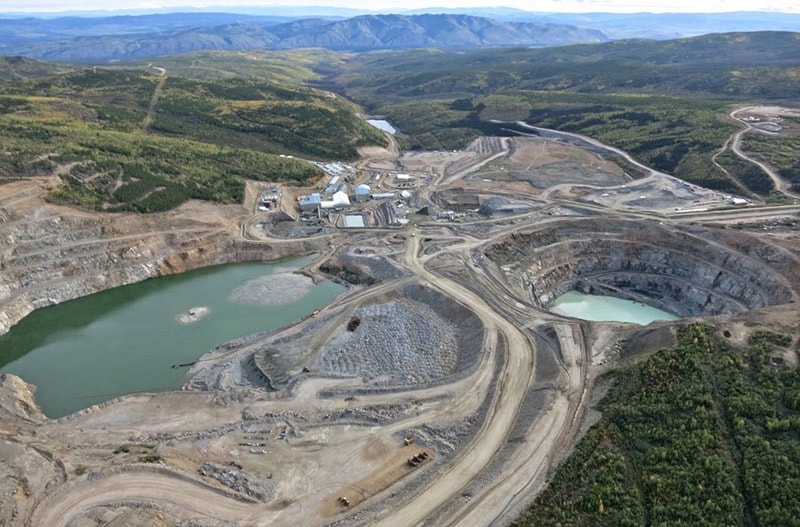The Minto mine’s water system was designed to handle rain and snow runoff in the early 1990s and the mine has been struggling to catch up with higher-than-expected levels since it opened in 2006, said Stephen Quin.
The Capstone Mining president was forced to make a second request to the Yukon Water Board this month to discharge water after all Minto’s storage areas filled up, said Quin.
The emergency release into the Yukon River Watershed is better than the alternative - a flood this fall or next spring that would carry unknown amounts of contaminants into the watershed, he said.
If next year’s rain and snow are as bad as last year’s, there would be “a million cubic metres of water coming over the dam and there would be no physical way to stop it,” said Quin, speaking from Minto.
A dam at the bottom of the mine collects water from the site’s drainage pipes. The water-storage pond filled up earlier this year when the unusually high level of snowpack began to melt.
Water was then diverted to the open pit where the mine does its digging, while piles of excavated ore were milled.
But the water is now past the rock walls and running along the dirt and gravel brim that surrounds the pit.
Any more water would be impossible to deal with.
“There would be nothing you could do about it,” said Quin.
The mine’s original licence was granted in 1996 based on hydrology tests in the early 1990s, he said.
When the mine started up nearly a decade later, something had seriously changed in the weather.
“We recognized in the first year there was more water on site,” said Quin.
The 1996 licence predicted that the mine’s dam would fill up in two years.
It only took five months.
“It was pretty apparent in the first year that there was more water, but the key discussion with the regulator is that you can’t amend a water management plan without science to support it,” said Quin.
So Capstone has been measuring water levels for two and a half years to develop a new water management plan that was delivered to the water board this month.
The plan will be based on weather and hydrology patterns over the last three years, said Quin.
The mine made one emergency discharge request last month, but the water board didn’t grant the whole amount Capstone had requested.
“The answer was, basically, go away and figure out what the solution is for the rest,” said Quin.
A number of avenues were examined, he said, but a second discharge was the only available alternative.
Capstone was especially concerned about the water freezing during the winter, and then runoff next spring would have nowhere to go.
Designing a mine’s water system on outdated data should be a no-no for the regulator, said Yukon Conservation Society mining co-ordinator Lewis Rifkind.
“There doesn’t seem to be an expiry date (on water licences),”
said Rifkind.
The same thing is happening with an Alaskan pipeline project that has licences dating to the early 1980s, he said.
The mine has been criticized by the conservation group for seeking an emergency discharge for profit because high-grade ore is stuck underwater in the pit.
The profit loss from having to mill low-grade ore is significant, said Quin.
The stockpiled ore is around half the grade of the ore in the pit, he said.
“So in a month, we produced half the amount of copper but our costs are still the same,” he said.
Milling the low-grade copper slashes profits to a third of what they were with high-grade.
“If (it costs) one dollar a pound with high-grade, and two dollars a pound with low-grade, and if copper sells at $2.50, your margin (of profit) goes from $1.50 to 50 cents,” he said.
The mine had enough ore left to last four months, but it has been milling the best stuff first.
“(Without the discharge) we would run out of ore some time in early winter and the mine would shut down,” said Quin.
While Quin was frank about the mine’s losses, the discharge is being done to prevent an environmental disaster.
“The economics are significant from a company’s perspective, but much more significant is what happens if we don’t discharge, because there is nowhere to store water,” he said.
“It’s better to have a controlled, managed discharge of clean water as opposed to water that is what it is,” he said.
The water in the current discharge will be treated if it goes to the storage pond, but not if it’s in the pit.
The water is well below federal standards for contaminant levels, said Quin.
“Economics is secondary to the environmental consequences of an uncontrolled discharge,” he said.
And the new management plan should work out the kinks of Minto’s early years.
“It’s not in our interest to have
discharges,” said Quin. “We want a long-term plan that works.”
Contact James Munson at
jamesm@yukon-news.com.
